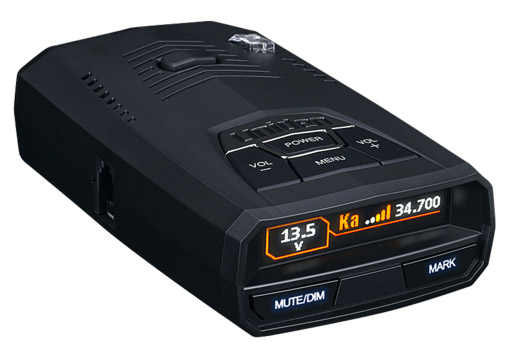 If you have a Uniden R4 or Uniden R4w, you can customize its settings to get better performance, filter out more false alerts, change the display color to match your vehicle’s interior, and further tweak it based on what’s best for you.
If you have a Uniden R4 or Uniden R4w, you can customize its settings to get better performance, filter out more false alerts, change the display color to match your vehicle’s interior, and further tweak it based on what’s best for you.
There’s no universal “best” settings for everyone since what’s best for you depends on both where you drive and your own personal preferences. That’s why they gave us options. 🙂
Purchase a Uniden R4 here and Purchase a Uniden R4w here.
Note these settings will also apply to both the R4 and R4w. They’re the same thing, but the R4w just adds WiFi.
In this guide, I’ll explain all the different features and settings to help you better understand your R4 series. At the very bottom of this article you’ll find my general recommended settings as well as the settings I run on my personal R4 and R4w. You can use these settings as a starting point and then customize them further based on what’s best for you.
Note: This guide is current as of R4 firmware 1.37 and R4w firmware 1.15 and will be updated when new firmware updates are released. (Last updated February 2025.)
Here are the video guides if you’d rather watch.
Functions of All the Different Buttons:
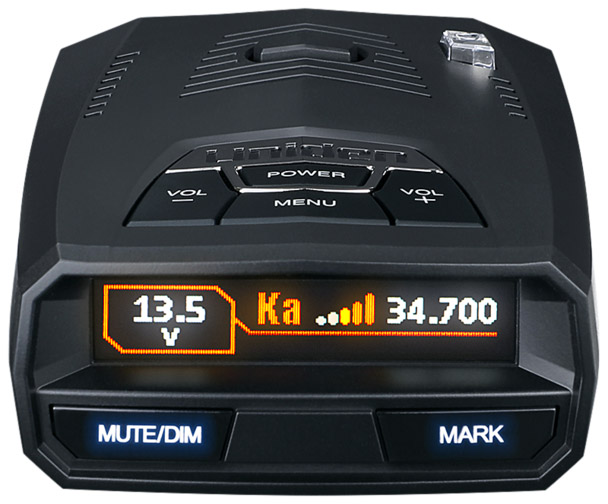
- Power: Turn the detector on or off
- Menu: Enter into the settings menu
- Long press will change between Highway / City / Auto / Advanced modes
- Vol -: Reduce the volume
- Go backwards through the menu options
- Vol +: Increase the volume
- Go forwards through the menu options
- Mute / Dim:
- Mute: Press once during any alert to mute the alert
- Lock out a false alert: Press twice during a stationary X or K band false alert to teach the detector that this is a false alert. It will remember this signal and automatically mute it for you in the future. (You can lock out MRCD and Ka band alerts too if you enable the option in the menu first.)
- Delete a RLC or Speed Camera: Long press during a red light camera or speed camera alert and it will prompt you to delete that particular alert from the detector’s database and not alert you to it again. Short press once to confirm.
- Adjust brightness: Press and hold when no alert is present to change the display brightness
- Bright
- Dim
- Dimmer
- Dark: Display is disabled and only lights up when an alert is present. When no alert is present, there will be a blinking dot that moves around in the bottom of the screen so you can verify that the detector is on.
- Off: Display and buttons are completely turned off at all times, giving you a fully blacked out detector at all times. Your audio will play normally still, of course.
- Auto: Automatically adjust between a brighter display during the day and a darker display at night.
- Mark:
- Short Press: Create GPS Mark so you get alerted every time you come by this area, useful for school zones, common speed trap locations, etc.
- Short Press during a Marked location alert: Delete GPS Mark
- Long Press: Bring up option to clear all GPS Marks (press again to confirm)
- Long Press during a K Band BSM False: Create a custom K Block around that frequency signal
Settings & Menu Options:
Note: You can download the R4 user manual and R4w user manual. They are a fantastic resource. This article will go into additional information.
Basic vs. Expert Menu
Choose if you want the menu to only show a few basic options, or if you want to unlock every option available.
Basic: Simplified menu option list, shows only the following settings:
- Auto / Advanced / Highway / City Sensitivity
- Auto City
- Main Volume
- Bluetooth (R4) or BT/WiFi (R4w)
- BT Pairing
- Speed Camera
- SpdCam d
- Redlight Cam
- RLC Q-Ride
- POI Passchime
- Voice
- Ka Freq Voice
- X Band
- K Band
- Ka Band
- Laser
- MRCD/T
- Gatso RT3/4
- Display Mode
- Scan Icon
- Display Info
- Alert Display
- Speed Unit
- Auto Mute Lv
- Auto Mute Vol
- Quiet Ride
- Q-Ride Beep Vol
- LimitSpeed
- Factory Reset?
- Delete All Mute?
- Delete All Auto?
- Delete All User?
- AP Name (R4w only)
- WiFi Update (R4w only)
- Firmware Version
- GPS DB Version
Expert: (default) Gives you access to every single menu option available. It adds the following options and controls to the Basic menu:
- GPS
- Laser Gun ID
- K POP
- Ka POP
- K Filter
- Ka Filter
- TSF
- K Blk 1-3
- K Usr 1-5
- K scanning ranges
- Ka scanning ranges, including Ka segmentation
- Alert Priority
- Mute Mem
- Auto Mute Mem
- Auto Mem
- All Threat
- Color
- Band Color
- Scan Icon
- Alert Tones
- Alert Temp Vol
- Dark Mode
- Auto Dim Setting
- Backlight
- Q-Ride MRCD/T
- GMT
- DST
- BAT Warning
- BAT Saver
- Self Test
- Memory Quota
Highway / City / Auto / Advanced
This lets you dial back the sensitivity of K band and X band to reduce false alerts around town. Ka band is always unaffected.
- Highway: (default) Full sensitivity on X, K, & Ka band.
- City: Full sensitivity on Ka band, reduced sensitivity on X and K band.
- Auto: Raises and lowers the sensitivity of X and K band based upon your speed.
- Advanced: You can individually dial back the sensitivity on X, K, or Ka band anywhere from 100% sensitivity to 30% sensitivity in 10% increments. Helpful if you’re getting too many falses and want to dial back the range.
Note: These are not different settings profiles. Switching to Advanced Mode doesn’t unlock any other features other than giving you more granular control of X/K/Ka band sensitivity. For K band sensitivity testing between the different modes, see here.
Auto City
Raise or lower the sensitivity of the detector on X and K band, depending on if you’re traveling above or below the Auto City speed threshold.
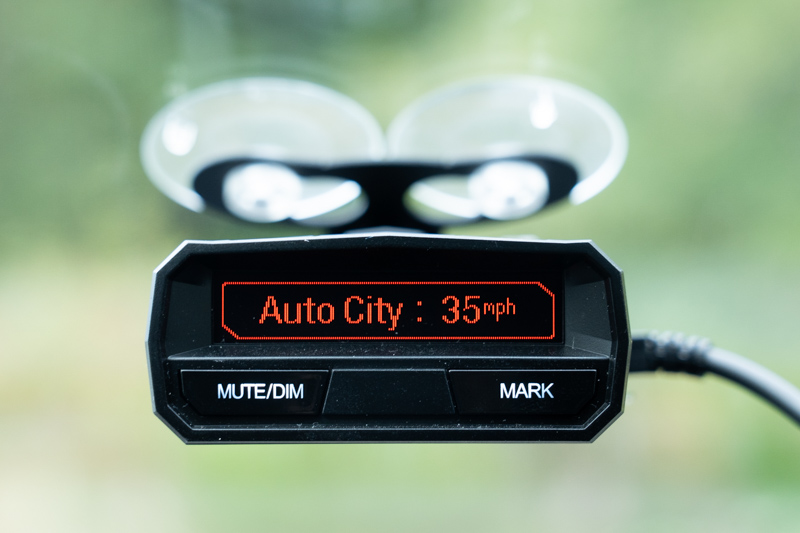
Based on previous testing, it looks like the detector effectively switches between Highway and City modes based on speed.
- 10 – 60 mph (10 – 100 km/h) in 5 mph (10 km/h) increments. (Default is 40 mph, 60 km/h)
Note: This option only appears when you set the detector’s sensitivity to Auto.
Main Volume
Adjust the volume of the detector. This is the same as hitting the + and – buttons on top of the detector.
- 0-8
Bluetooth (R4), BT/WiFi (R4w)
Enable the Bluetooth functionality with your R4 or both Bluetooth and WiFi on the R4w.
- On (Default)
- Off
Android Apps: Uniden R/TACH, Highway Radar
iOS Apps: Uniden R/TACH, V1Driver, & R4 Companion
BT Pairing
Initiate the pairing process between your R4 and your phone.
Read this tutorial for instructions on how to pair your R4 to your Android.
GPS
Enable the R4’s GPS-related features and false alert filters.
- On (default)
- Off
Speed Camera
Alert you to speed cameras ahead.
You can mute speed camera alerts by pressing the mute button. You can delete them by long pressing the mute button (and short pressing a second time to confirm).
- On (default)
- Off
Speed Cam Distance
Adjust the alert distance you’d like the R4 to let you know about speed cameras. (This setting shows up as “SpdCam d” in the detector.)
- Auto
- 1000 ft / 300 m (default)
- 2000 ft / 600 m
- 2500 ft / 760 m
- 3000 ft / 900m
Auto mode applies just to speed cameras and varies your alert distance based on the speed limit threshold in the speed camera. (Below are the alert distances from the R7 and I’m assuming they’re the same here.)
- Speed limit 50 or 60 km/h: Alert range 600m
- Speed limit 70 or 80 km/h: Alert range 700m
- Speed limit 100, 110, or 120 km/h: Alert range 800m
Redlight Cam
Alert you to redlight cameras ahead.
You can mute RLC alerts by pressing the mute button. You can delete them by long pressing the mute button (and short pressing a second time to confirm).
- On (default)
- Off
RLC Q-Ride
High speed muting for redlight cameras. This is useful for muting RLC/speedcam alerts on nearby surface streets when you’re driving down the highway.
You can mute individual alerts by pressing the mute button. You can delete them by long pressing the mute button (and short pressing a second time to confirm).
- Off (default)
- 50 – 85 mph (80 – 140 km/h) in 5 mph (10 km/h) increments
POI Passchime
Audibly play a chime when you pass a fixed point of interest like a speed cam or redlight camera. Some people find that alert annoying so you have the option to disable the chime if you like.
- On
- Off (default)
Voice
Voice announcements for radar and laser alerts (ie. “Ka band”) to make it easier to identify different bands by sound. This is especially useful while you’re learning what the beeps for each individual band sound like.
This will also speak the individual menu options when you scroll through.
- On (default)
- Off
Ka Freq Voice
Verbally announces the exact frequency of Ka band radar alerts. Useful for identifying the frequency of the Ka band signal without needing to look at the display. The detector will beep normally for a moment, announce the frequency, and then resume alerting.
- On
- Off (default)
X Band
Enable or disable X band.
X band has been mostly phased out around the country. It’s still actively in use in OH and southern NJ and a few small areas around the country.
To find out what bands are in use in your area, click here.
- On
- Off (default)
K Band
Enable or disable K band.
K band is in use virtually everywhere around the country. The notable exception is virtually all of CA where you can disable K band and cut off the false alerts you’d otherwise have to deal with using the detector’s filters.
To find out what bands are in use in your area, click here.
- On (default)
- Off
Ka Band
Enable or disable Ka band.
This is a very common police radar band and it’s in use nationwide. Definitely best to leave this on.
- On (default)
- Off
Laser
Enable or disable alerts when you get shot by laser.
- On (default)
- Off
Laser Gun ID
Enabling this will let you know which laser gun the officer is using (make or model) when your R4 detects laser.
- On
- Off (default)
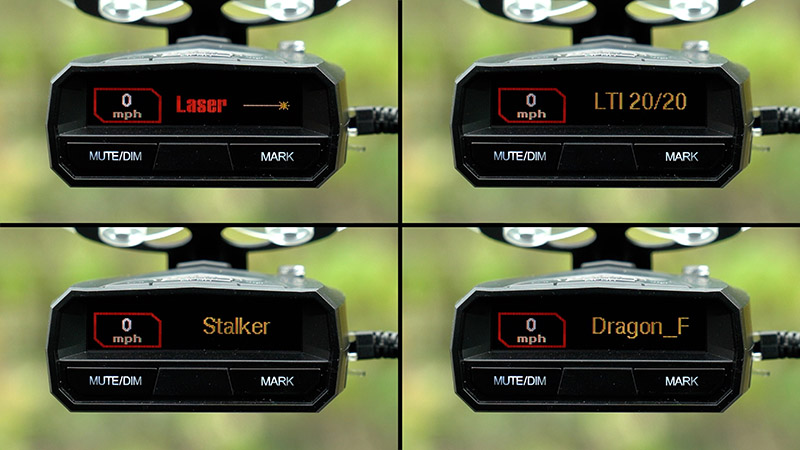
Not all guns are ID’ed in my testing, but most of them are.
Laser TP
Enables Uniden’s add-on laser jammers (laser transponders).
- On (Default)
- Off
Note 1: This feature will only show up on the R4w when the laser jammers are plugged in.
Note 2: This feature has been removed from the R4 since firmware 1.36. Hopefully Uniden re-adds it in a future firmware update.
Constant / Pulse / Receive Mode
Control how the laser transponders / jammers behave when you get shot with laser.
- Constant Mode: Unlimited jamming, used only for testing purposes. (Default)
- Pulse Mode: Automatically stop jamming after 10 seconds.
- Receive Mode: Detect laser only, but do not jam.
The AutoJTK time of 10 sec in Pulse Mode is unfortunately not adjustable. There is also currently no way to manually JTK either. IMO this MUST be changed once the jammers are released so we can tell the jammer to stop jamming.
Note 1: This setting only shows up when “Laser TP” is turned on.
Note 2: This feature will only show up on the R4w when the laser jammers are plugged in.
Note 3: This feature has been removed from the R4 since firmware 1.36. Hopefully Uniden re-adds it in a future firmware update.
Laser TP Setting
Tell the detector which heads are installed in the front or rear of your vehicle, as well as how the heads should behave when you get shot with a DragonEye.
TP1 – TP6 correspond to the 6 transponders.
- Front / Rx: Front transponder, Receive
- Front / Tx: Front transponder, Transmit
- Rear / Rx: Rear transponder, Receive
- Rear / Tx: Rear transponder, Transmit
Pro tip: Reference the Uniden R9 install manual, specifically pages 10-11, to see Uniden’s recommendations on which heads should be configured as transmitters and receivers.
Note 1: This setting only shows up when “Laser TP” is turned on.
Note 2: This feature will only show up on the R4w when the laser jammers are plugged in.
Note 3: This feature has been removed from the R4 since firmware 1.36. Hopefully Uniden re-adds it in a future firmware update.
K POP
67 ms K band POP detection.
K band POP is virtually nonexistent in real life and it’s best to leave this turned off for reduced false alerts.
- On
- Off (default)
MRCD/T
The MultaRadar CD and CT are low powered radar guns that are primarily used overseas. However, we are now seeing them here around Edmonton in Alberta, Quebec, Chicago, NYC, and in Maryland near Washington D.C. If you enable MRCD detection, you will be able to detect these radar sources.
- On
- Off (default)
Gatso RT3/4
The Gatso RT3 and RT4 are similar photo radar systems in use. Enable this option to detect the Gatsos.
In the US, so far some Gatso usage has been reported in Maryland, Iowa, Ohio, and certain parts of California. However, so far testing is showing the Gatso detection to be ineffective.
The R4 falses to Gatso even more than MultaRadar so leave this disabled unless needed.
- On
- Off (default)
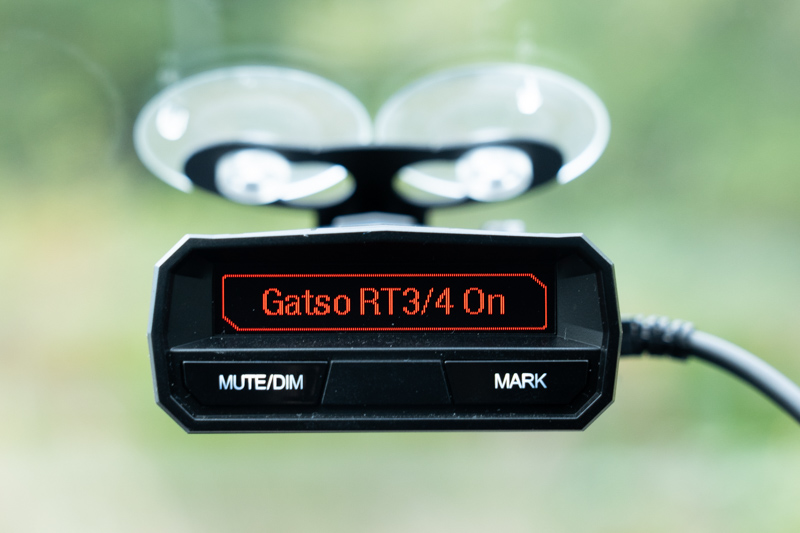
Ka POP
67 ms Ka band POP detection.
Ka band POP is also nearly nonexistent in real life so it’s generally better to turn this off.
- On
- Off (default)
K Filter
Filter out blind spot false alerts from other nearby vehicles. Definitely run with this on.
- On (default)
- Off
Ka Filter
Filter out false alerts on Ka band. In other Unidens, it slows down reactivity by about 0.1s, so not much at all. Even with it on, the detector is still very fast. It has much less of an impact to performance than Escort’s RDR or the V1’s Ka Guard does. If you’d like maximum performance, turn this off.
- On
- Off (default)
TSF
The traffic sensor filter is designed to filter out K band traffic sensors along the highway in some areas. Enabling it does slow down reactivity on K band and negatively affect range somewhat. However, if you have traffic sensors on your highways and experience regular and repeated K band falses from them, turn TSF on. Additionally, some people also like using this option to further help filter out some blind spot falses as well.
- On
- Off (default)
K Blk1
K Block 1 is a filter designed to help filter out blind spot monitoring (BSM) falses from nearby Hondas, Acuras, and some Chryslers transmitting around 24.199 GHz +/- 5 MHz.
- On: Completely filter out and ignore all signals within this freq. range.
- Weak: (default) Filter out and ignore any weak signals in this range. This can be useful to knock out weak BSM’s, but still alert to officers with stronger radar guns, at the expense of reduced range.
- Mute: Audibly mute all signals within this range, but visually show them on screen so you know they’re present.
- Off: Disable this filter altogether.
K Blk2
K Block 2 is the same idea as K Block 1, except it operates at 24.168 GHz +/- 2 MHz. This also helps with some Hondas, Acuras, as well as some GM’s.
- On: Completely filter out and ignore all signals within this freq. range.
- Weak: (default) Filter out and ignore any weak signals in this range. This can be useful to knock out weak BSM’s, but still alert to officers with stronger radar guns, at the expense of reduced range.
- Mute: Audibly mute all signals within this range, but visually show them on screen so you know they’re present.
- Off: Disable this filter altogether.
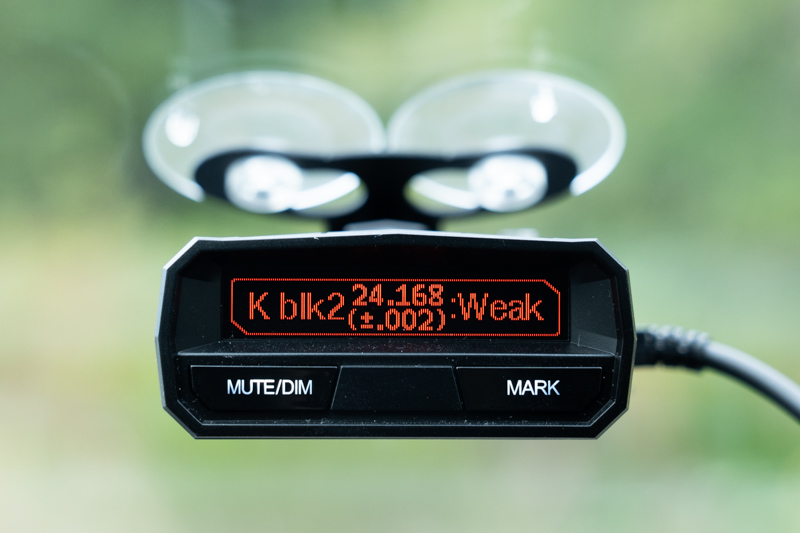
K Blk3
K Block 3 operates at 24.123 – 24.124 GHz. This specifically helps target Mazda CX-5 SUV’s.
- On: Completely filter out and ignore all signals within this freq. range.
- Weak: (default) Filter out and ignore any weak signals in this range. This can be useful to knock out weak BSM’s, but still alert to officers with stronger radar guns, at the expense of reduced range.
- Mute: Audibly mute all signals within this range, but visually show them on screen so you know they’re present.
- Off: Disable this filter altogether.
K Usr 1-5
These are open slots to create 5 more custom K Blocks to knock out additional BSM falses such as 24.160 falses.
- On: Filter out all signals
- Weak: Filters out only weak signals (Default)
- Mute: Audibly mute all signals
- Off: Disable K Block
I haven’t relied on these much since I use R4 Companion which handles additional BSM muting for me, but I like that we now have the option to handle these falses natively in the detector. Check out @DC Fluid’s suggestions on custom K blocks for additional insight and discussion.
K Wide / Narrow / Extended
This gives you the option to adjust the range of frequencies that the detectors scans for on K band, cutting out frequencies where you’re less likely to see legitimate K band radar, thus helping reduce your number of false alerts.
Police officers often transmit throughout the entire range that K Wide covers so if K band is actively used in your area, it’s best to run with K Wide. If not, you can consider switching to K Narrow. K Extended is useful for even lower end K band, especially for photo radar.
- K Wide: (default) 24.050 – 24.250 GHz
- K Narrow: 24.080 – 24.200 GHz
- K Extended: 23.900 – 24.250 GHz
Note: I’m not sure of the exact freq. ranges of the R4, so for now I’m assuming they’re the same as the R7.
Ka Wide / Narrow / Segmentation
Alert to all the entire Ka band spectrum or only the Ka frequencies where police generally operate on.
- Ka Wide: 33.4 GHz – 35.7 GHz
- Ka Narrow: (default) 33.8 +/- 100 MHz, 34.7 +/- 120 MHz, 35.5 +/- 100 MHz
- Ka Segmentation:
- Ka 1: 33.399 – 33.705
- Ka 2: 33.705 – 33.903 (MPH radar guns at 33.8)
- Ka 3: 33.903 – 34.191
- Ka 4: 34.191 – 34.587 (Stalkers that drift low)
- Ka 5: 34.587 – 34.803 (Stalker radar guns at 34.7)
- Ka 6: 34.803 – 35.163 (Stalkers that drift high)
- Ka 7: 35.163 – 35.379
- Ka 8: 35.379 – 35.613 (Kustom and Decatur radar guns at 35.5)
- Ka 9: 35.613 – 35.701
In general, Ka Narrow is fine for much of the US with its 2/5/8 sweep. Ka Wide is recommended if you encounter out of tune guns such as if you drive in New York.
Ka Segmentation gives you more fine tuned control over which segments you do or do not sweep. I like adding segments 4 & 6 to detect those drifting Stalkers.
Finally, if you’re wondering specifically which additional segments are recommended for different States, beyond the traditional 2/5/8, please see this post.
MRCD/KA / Signal Priority
If the detector is detecting multiple signals, you can choose which signal is given audible and visual priority.
- MRCD/Ka Priority: (default) Gives you band priority alerts where if you’re seeing multiple signals, alert priority will be given to MRCD, Ka, K, & X in that order. This is nice because MRCD is usually close range with minimal alert distance.
- Ka/MRCD Priority: Similar to above, but lets you prioritize Ka band alerts over MRCD. Alert priority here is Ka, MRCD, K, X band in that order.
- Signal Priority: Gives alert priority to the strongest (usually closest) signal.
So for example if you’re getting a strong K band signal and a weak Ka band signal, Signal Priority will alert you to the K band signal while Ka Priority will focus on the Ka band signal. If you have the all threat display option enabled (discussed next), the secondary signal will show up on screen next to the primary signal, but the audio will always be focused on the primary signal.
Note: If you have MRCD disabled, the only two options will be “Ka Priority” or “Signal Priority.”
Mute Mem
By default the detector will only allow you to lock out X and K band sources. This makes sense since there is generally where you’ll find your stationary false alerts. However, some people have speed signs in their area that transmit on Ka band or neighbors with satellite dishes that cause Ka falses so if you’d to be able to lock out Ka band sources too, you can tell the detector to let you lock out X, K, and Ka alerts.
- X & K: (default) Lock out only X and K band signals.
- X, K, Ka: Add the ability to lock out Ka band & MRCD too.
Be careful when using Ka lockouts. It can be pretty risky and most manufacturers don’t even allow this option at all because of the fact that Ka alerts are almost always real. If you want to use Ka lockouts, such as you have a Ka band speed sign or satellite dish that falses your R4, make sure you’re 100% confident the Ka band alert is being triggered by a stationary false source that you see every time you pass by before you lock the signal out.
Auto Mute Mem
Enable automatic GPS lockouts. With this enabled, after several passes of a stationary false alert (ie. shopping center door opener or a fixed speed sign), the detector will automatically learn this false alert and mute it for you in the future.
- On (default)
- Off
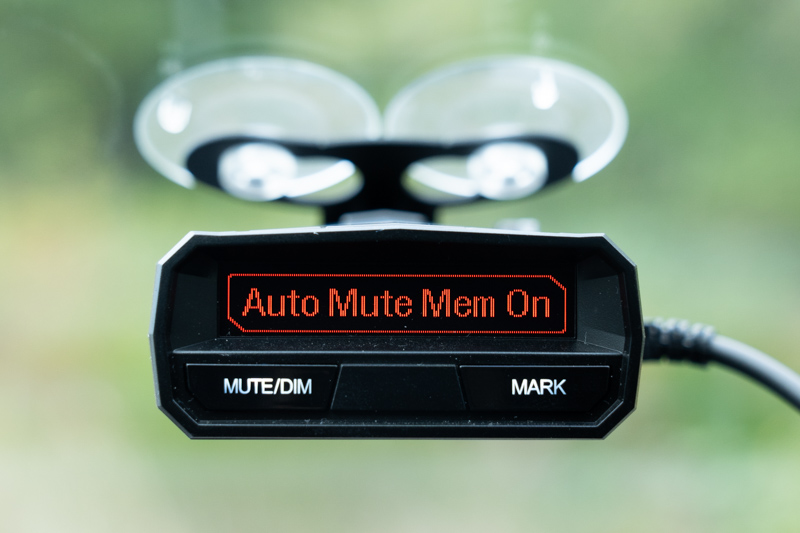
Note: In my experience, locked out signals don’t always stay locked out and may alert again in the future. I think this feature needs improvement.
Auto Mem
Choose which radar bands can be automatically locked out.
- X & K (default)
- X K Ka (also applies to MRCD)
All Threat Display
When the detector is picking up more than one signal, it can show the band and signal strength of any additional signals (up to 3 more) on the left side of the screen where the speedometer/voltmeter would normally go. When only one signal is present, that left side of the screen stays as a speedometer/voltmeter.
- On
- Off (default)
Color
Choose what color display you’d like. The options include:
- Red (default)
- White
- Purple
- Blue
- Amber
- Green
- Pink
- Gray
This can be helpful to match your vehicle’s interior, for example.
Band Color
Customize the color for when the R4 displays a specific radar alert on screen.
You can also set this to “Signal” so the color changes relative to signal strength.
- X Band
- K Band
- MRCD/T
- Gatso
- Ka Band
Note: This only affects the letters “K” or “Ka,” for example, but not the signal frequency.
Mode / Time / Scan Display
Change what is showing up on screen when you’re not getting an alert.
- Mode: (default) Display the words Highway, City, Auto, or Advanced on screen.
- Time: Display the current time, determined by GPS.
- Scan: Display an animated pulse-like heartbeat scanner on screen.
Scan Icon
Display a blinking heart icon in the top left corner of the display.
- On
- Off (default)
Display
Choose what you want to be displayed on the left side of the screen including:
- Speed (default)
- Speed and Compass
- Compass
- Voltage
- Altitude
My preference is either speed or speed + compass. I like speed and compass, but sometimes when you’re stationary, especially when you first start your car and haven’t started moving, the compass just spins around and I find this annoying and unhelpful, but the compass is helpful while driving.
Alert Display
Choose how alerts look on screen when the pop up.
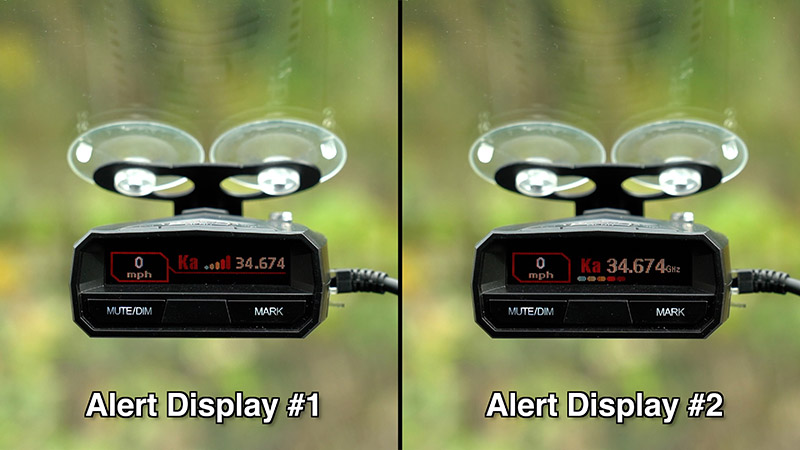
I prefer #2 since the alerts are a bit larger.
- #1 (default)
- #2
Speed Unit
Display your speed in MPH or KM/H and distances in feet or meters.
- MPH (default)
- KM/H
Tones
Choose between 12 different alert tones for any of the radar bands or for laser. Scroll through the different options to listen to what the alert tones sound like.
The K & Ka bogey alert options have 5 different alert tones that you can choose between that will alert you to the presence of an additional signal (bogey) detected when the detector was already alerting to a previously detected signal.
K bogey level lets you choose the volume level of the K band bogey tone, separate from the main volume.
Auto Mute Level
This sets the signal strength level where the auto mute applies, letting you only auto mute weak signals.
For example, for weak signals farther away, the auto mute can kick in after a few seconds to quiet the detector down for you and then unmute as you get closer as the signal gets stronger. Additionally, if you detect a strong signal right out of the gate, like getting hit with close range instant on, the detector will continue alerting loudly without the auto mute quieting down the detector. This auto mute level option ensures that the detector will only mute weaker and less risky signals while alerting you to stronger and closer signals.
Note: If you set it to 8 (the strongest signal threshold), automuted signals will always stay muted and will never unmute, even when the signal hits full strength.
- Off
- 1-8
Auto Mute Volume
If the Auto Mute option is enabled, choose how loud or quiet the detector alerts once it drops down to the auto muted volume level.
- 0-8 (Default = 2)
Note: If your normal audio volume and auto mute volume are the same, it will “drop” to the same level and seem like the auto mute feature isn’t working. Be sure your auto mute volume level is set lower than your normal alert volume.
Alert Temp Volume
This gives you the option to temporarily reduce the volume of the current alert. While you can always fully mute the detector altogether during an alert, if you want to manually lower the volume instead so you can still hear the beeps quietly in the background, you now have the option to lower the volume of the detector (using the volume buttons on top) while it’s busy alerting.
The signal will stay at reduced volume until after the signal is gone and the mute latch expires. Any new signals that arise at any point will also alert at normal volume.
- Off (Default)
- On
Dark Mode
You have the ability to adjust how bright the display is if you set it into dark mode. The display will be off in dark mode (with a blinking dot moving at the bottom of the screen) until you get an alert. When an alert pops up, how bright do you want the display to be?
- Bright
- Dim
- Dimmer (default)
Auto Dim Setting
Adjust the settings for the auto dim brightness level.
Note: You must first select “Auto” as the display brightness in order to have this option show up in the menu.
- Mode: Sensor: (default) Adjust the display brightness using the built-in ambient light sensor
- Mode: Time: Adjust the display brightness based on the current time
If you choose the time option, you get a few more options:
- Bright time: Adjust what time the detector switches to the bright display in the morning. Select between 5:30am – 7:30am in 15 min increments.
- Bright level: Bright (default), Dim, Dimmer
- Dim time: Adjust what time the detector switches to the dim display in the evening. Select between 5pm – 8pm in 15 min increments.
- Dim level: Bright, Dim (default), Dimmer, Dark, Off
Backlight
Makes the front two buttons underneath the display glow from behind so you can find them more easily at night. You can turn it off if you want a stealthier look.
- On (default)
- Off
Quiet Ride
Low speed muting. This automatically mutes any and all X band and K band alerts, whether they’re real alerts or false alerts, when traveling below the speed you select. This feature is incredibly valuable around town to deal with false alerts while driving around city streets or while in shopping center parking lots.
- Off (default)
- 5 – 90 mph (10 – 140 km /h) in 5 mph (10 km/h) increments
Q-Ride MRCD/T
Individually control if MRCD/T alerts are also affected by quiet ride’s low speed muting. MultaRadar photo radar is often run on city streets and at close range so you can choose to have quiet ride disabled for MultaRadar so it alerts you at low speed, even if traditional radar is being muted.
- Off (default)
- On
Q-Ride Beep Vol
Adjust the volume of signals when traveling below the quiet ride speed threshold. I like keeping this low to keep the detector quieter when traveling at low speeds.
Setting this to “0” mutes the detector on X and K band signals at low speeds, useful for shopping center parking lots.
- 0-8 (Default 1)
LimitSpeed
Audibly warn you when you travel over a preset speed. Helpful to remind you when you’re traveling above the speed limit, for example.
- Off (default)
- 50 – 100 mph (80 – 160 km/h) in 5 mph (10 km /h) increments
GMT
Choose your time zone and the time will automatically be set via GPS.
- GMT – 5 Hour: Eastern
- GMT – 6 Hour: Central
- GMT – 7 Hour: Mountain
- GMT – 8 Hour: Pacific (default)
DST
Daylight savings time adjustment. If you’ve set your time zone but the clock is off by 1 hour, change this setting.
- On
- Off (default)
BAT Warning
Audible warning when your battery drops too low (below 11v). Helpful as a reminder if you’re running your vehicle with the engine off and the battery level starts dropping pretty low.
- On
- Off (default)
BAT Saver
If your detector is plugged into a power source that doesn’t turn off when you turn off your car, turn this on so your detector doesn’t drain your car battery.
It turns the detector off when you’ve been stationary (parked) for 1 hour.
It also turns the detector off if the GPS hasn’t connected for an hour (like when you’re in a parking deck or garage).
- On
- Off (default)
Self Test
Run a self-diagnostic test every time you start your detector. You can turn this off for a faster and quieter bootup process.
- On (default)
- Off
Factory Reset?
Reset your detector’s settings to factory defaults.
This does NOT delete your GPS lockouts or manually marked locations.
Delete All Mute?
Delete all of your manual GPS lockouts.
Delete All Auto?
Delete all of your automatic GPS lockouts.
Delete All User?
Delete all of your manually marked locations that you created by pressing the Mark button.
Memory Quota
The R4 & R4w support 2,000 memory locations, split between GPS lockouts and manual GPS user marks. By default the R4’s give you 1,750 manual lockouts and 250 user marks. Personally I use GPS lockouts all the time and rarely/never use the GPS marks, so I like allocating most of the available space to GPS lockouts. The default option does exactly this.
Note: This applies to Manual GPS lockouts only. Auto lockouts have way more memory allocated separately and isn’t something you adjust.
You can change how many manual lockout and user mark locations are available with the – and + buttons on top of the R4 and this change will be shown in white text. The bottom text in red stays put as your current/previous settings. Press the Menu button up top twice to change to your new settings.
AP Name (R4w only)
Displays the SSID of the WiFi hotspot that the R4w is connected to.
Press ‘Menu’ to delete the current hotspot that the R4w is set to connect to.
WiFi Update (R4w only)
This is how you update your R4w over WiFi.
When it’s connected, you’ll see a WiFi icon on the idle screen. When an update is available, you’ll see a second download icon next to the WiFi icon.
- Full: Update both the firmware and the GPS database
- DB: Update only the GPS database of red light cams and speed cams
- Exit
Ver.
Tells you the firmware and DSP firmware version of the detector.
You can check for the current R4 firmware version and the current R4w firmware version on Uniden’s website or via their update software.
DB Ver
Date (version) of the current redlight camera database.
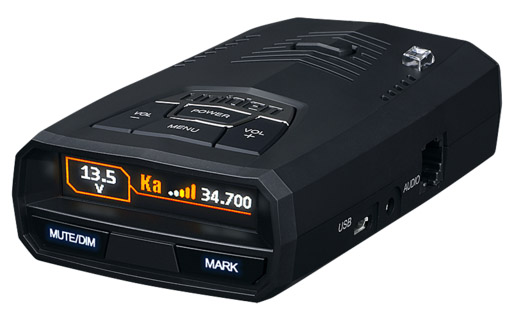
General Recommended R4 / R4w Settings
If you’re wondering what settings you should run, I’d recommend that you read over this guide and take the time to understand what each option does so you can make an educated decision regarding what would be best for you. If you’d like a quick general recommendation that would work for most everyone nationwide, particularly as a starting point to build on, here’s a list of my generic recommended settings. These are designed to be safe, give you good performance and filtering, and be applicable all across the country.
Note: I put a (*) in front of every option that I’ve changed from the factory defaults.
- Expert
- *Auto
- Auto City: 40 mph
- Main Volume: 4
- Bluetooth / BT WiFi: On
- GPS: On
- Speed Camera: On
- SpdCam Distance: 1000 ft
- Redlight Camera: On
- *RLC Q-Ride: 60mph
- POI Passchime: Off
- Voice: On
- *Ka Freq Voice: On
- X Band: Off (If you drive in OH or NJ, turn this on.)
- K Band: On (If you drive in CA, you can typically turn this off.)
- Ka Band: On
- Laser: On
- *Laser Gun ID: On
- K POP: Off
- MRCD/T: Off (unless you drive in Alberta, Quebec, Chicago, NYC, or MD)
- Gatso RT3/4: Off (unless you drive in MD, IA, OH, & certain parts of CA)
- Ka POP: Off
- K Filter: On
- Ka Filter: Off
- *TSF: On
- *K Block 1: Lv 3.5 (24.190 – 24.219) – Honda, Acura
- *K Block 2: Lv 2.5 (24.165 – 24.173) – Very common BSM, many brands, Asian & domestic
- *K Block 3: Lv Weak (24.123 – 24.124) – Mazda CX-5
- *K User1: Lv 2.0 (24.058 – 24.089) – Cadillac
- *K User2: Lv 2.0 (24.149 – 24.155) – Jeep, Stellantis
- *K User3: Lv 2.0 (24.157 – 24.162) – Jeep, Stellantis, GM
- *K User4: Lv 2.5 (24.230 – 24.235) – Honda, Hyundai
- K User5: Off (23.900 – 23.900)
- K Wide
- *Ka Segmentation: Enable Ka 2/4/5/6/8
- Ka Priority (or MRCD/Ka Priority if MRCD/T is needed)
- Mute Mem: X & K
- Auto Mute Mem: On
- Auto Mute Mem: X & K
- *All Threat: On
- Color: Red
- Band Color (Defaults)
- *Scan: Time Display
- Scan Icon: Off
- *Display: Speed + Compass
- *Alert Display: #2
- Speed Unit: mph
- Tones:
- X Band Tone: 1
- K Band Tone: 2
- *K Bogey Tone: Off
- *MRCD Tone: 7
- Ka Band Tone: 3
- Ka Bogey Tone: 1
- Laser Tone: 4
- Auto Mute Lv: 5
- Auto Mute Vol: 2
- Alert Temp Vol: Off
- Dark Mode: Dimmer
- Auto Dim Settings:
- Mode: Sensor
- Bright level: Bright
- Dim level: Dim
- Backlight: On
- *Quiet Ride: 35mph
- Q-Ride MRCD/T: Off
- Q-Ride Beep Vol: 1
- Limit Speed: Off
- *GMT (Choose your specific time zone)
- *DST: On in summer, Off in winter
- *BAT Warning: On
- *BAT Saver: On
- *Self Test: Off
- *Memory Quota: Mute 1750, User 250
Download my R4 General Recommended Settings here.
Download my R4w General Recommended Settings here.
You can load these into your R4 or R4w by plugging your detector into your computer, running Uniden’s update software, clicking “User Setting,” and then clicking the “Open from file” button at the bottom, selecting this file, then clicking “Store to unit” at the bottom.
Vortex’s Personal R4 / R4w Settings
Here’s the settings that I run myself. These settings are not necessarily what’s best for you, but for informational purposes, they’re what I typically use nowadays around here where it’s almost exclusively Ka and Laser. MRCD and Gatso not in use here and K band is very rare around here, so unless I’m out on a road trip to somewhere new, I really like the detector extra quiet on K band, especially when someone else is in the car with me, so I filter K band pretty aggressively.
Note: I put a (*) in front of every option that I’ve changed from the factory defaults.
- Expert
- *Auto
- Auto City: 40 mph
- Main Volume: 4
- Bluetooth: On
- GPS: On
- Speed Camera: On
- SpdCam Distance: 1000 ft
- Redlight Camera: On
- *RLC Q-Ride: 60mph
- POI Passchime: Off
- *Voice: Off
- *Ka Freq Voice: On
- X Band: Off (If you drive in OH or NJ, turn this on.)
- K Band: On (If you drive in CA, you can typically turn this off.)
- Ka Band: On
- Laser: On
- *Laser Gun ID: On
- K POP: Off
- MRCD/T: Off (unless you drive in Alberta, Quebec, Chicago, NYC, or MD)
- Gatso RT3/4: Off (unless you drive in MD, IA, OH, & certain parts of CA)
- Ka POP: Off
- K Filter: On
- Ka Filter: Off
- *TSF: On
- *K Block 1: Lv 3.5 (24.190 – 24.219) – Honda, Acura
- *K Block 2: Lv 2.5 (24.165 – 24.173) – Very common BSM, many brands, Asian & domestic
- *K Block 3: Lv Weak (24.123 – 24.124) – Mazda CX-5
- *K User1: Lv 2.0 (24.058 – 24.089) – Cadillac
- *K User2: Lv 2.0 (24.149 – 24.155) – Jeep, Stellantis
- *K User3: Lv 2.0 (24.157 – 24.162) – Jeep, Stellantis, GM
- *K User4: Lv 2.5 (24.230 – 24.235) – Honda, Hyundai
- K User5: Off (23.900 – 23.900)
- *K Narrow
- *Ka Segmentation: Enable Ka 2/4/5/6/7/8
- Ka Priority (or MRCD/Ka Priority if MRCD/T is needed)
- Mute Mem: X & K
- Auto Mute Mem: On
- Auto Mute Mem: X & K
- *All Threat: On
- Color: Red
- Band Color (Defaults)
- *Scan: Time Display
- Scan Icon: Off
- *Display: Speed + Compass
- *Alert Display: #2
- Speed Unit: mph
- Tones:
- X Band Tone: 1
- K Band Tone: 2
- *K Bogey Tone: Off
- *MRCD Tone: 7
- Ka Band Tone: 3
- Ka Bogey Tone: 1
- Laser Tone: 4
- Auto Mute Lv: 5
- Auto Mute Vol: 2
- *Alert Temp Vol: On
- Dark Mode: Dimmer
- Auto Dim Settings:
- Mode: Sensor
- Bright level: Bright
- Dim level: Dim
- Backlight: On
- *Quiet Ride: 35mph
- Q-Ride MRCD/T: Off
- *Q-Ride Beep Vol: 0
- Limit Speed: Off
- *GMT: -8
- *DST: On in summer, Off in winter
- BAT Warning: Off
- BAT Saver: Off
- *Self Test: Off
- *Memory Quota: Mute 1750, User 250
Download my Personal R4 Settings here or download my Personal R4w Settings here after taking the time to first read the settings so you know what you’re getting.
You can load these into your R4 or R4w by plugging your detector into your computer, running Uniden’s update software, clicking “User Setting,” and then clicking the “Open from file” button at the bottom, selecting this file, then clicking “Store to unit” at the bottom.
Note: This currently only works on the Windows update software. Uniden needs to update their Mac software to restore this functionality.
If you need to purchase the detector, you can purchase the R4 here and purchase the R4w here.
| This website contains affiliate links and I sometimes make commissions on purchases. All opinions are my own. I don’t do paid or sponsored reviews. Click here to read my affiliate disclosure. |

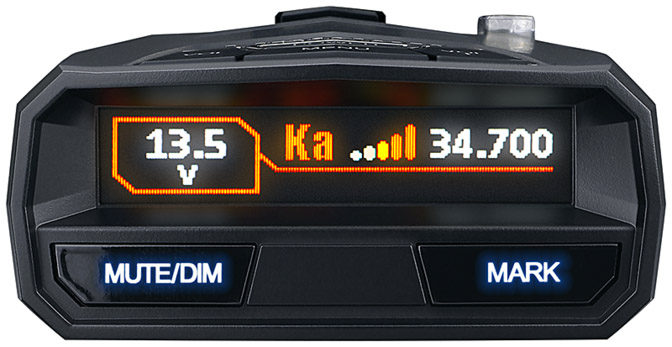

12 comments
Skip to comment form
Thank you Vortex for all that you do , too bring great info and honest reviews. I just picked up a Uniden R4 and setting up to run with your presets. Thank you
Yes Thanks ! – I also picked up an R4 based on your reviews and link to purchase – it arrived in 3 days from Best Radar Detectors.
Where is the Bluetooth? Uniden does not show Bluetooth capability for the R4. Will it be activated with a future firmware update?
Author
Right, it should be available later. It has the hardware, but it’s not active in software yet.
Are the KA bands suggested broader than the default KA narrow setting?
Author
If you scroll to the Ka Wide / Narrow / Segmentation segmentation of this article, you can see both what the default Ka Narrow sweeps for as well as what my suggested sweeps cover.
Hi Ariel,
First thing your videos and website is by far the best source of information hands down thank you.
I bought the R3 a few years ago based on your review for my motorcycle & car and it saved my butt many of times. I just now got a R4 off of Amazon. Question , Can you recommend a way to hear it better under my helmet without using the earpiece ?
Best regards,
Joe Myrtle Beach
Author
Hey Joe,
For motorcycle usage, including getting audio to your helmet, you can check out these two videos:
https://www.youtube.com/watch?v=yy7B45wgfVc
Thank you so much. Have a blessed day.
Can I power the R4 from my 2021 Lexus ES 350 USB port to the RJ11 port?
I just received an R4W. Using v2.22 of the update tool on windows PC I could not load the user settings file R4-Vortex-Personal-Settings-136.bin.
Is there a bin file for R4W?
Author
I wish they were cross-compatible too. 🙂 The article is now updated with R4w-specific files you can download.